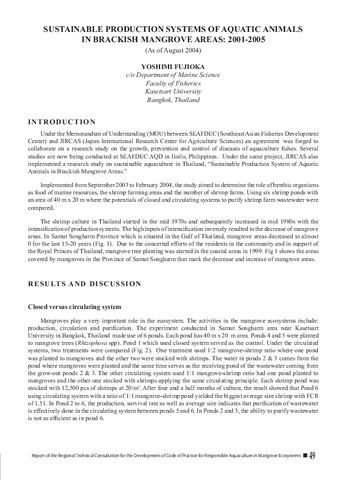Sustainable production systems of aquatic animals in brackish mangrove areas: 2001-2005 (As of August 2004).
- Global styles
- MLA
- Vancouver
- Elsevier - Harvard
- APA
- Help
Share
Abstract
Under the Memorandum of Understanding (MOU) between SEAFDEC (Southeast Asian Fisheries Development Center) and JIRCAS (Japan International Research Center for Agriculture Sciences) an agreement was forged to collaborate on a research study on the growth, prevention and control of diseases of aquaculture fishes. Several studies are now being conducted at SEAFDEC AQD in Iloilo, Philippines. Under the same project, JIRCAS also implemented a research study on sustainable aquaculture in Thailand, “Sustainable Production System of Aquatic Animals in Brackish Mangrove Areas.”
Implemented from September 2003 to February 2004, the study aimed to determine the role of benthic organisms as food of marine resources, the shrimp farming areas and the number of shrimp farms. Using six shrimp ponds with an area of 40 m x 20 m where the potentials of closed and circulating systems to purify shrimp farm wastewater were compared.
The shrimp culture in Thailand started in the mid 1970s and subsequently increased in mid 1980s with the intensification of production systems. The high inputs of intensification inversely resulted to the decrease of mangrove areas. In Samut Songharm Province which is situated in the Gulf of Thailand, mangrove areas decreased to almost 0 for the last 15-20 years (Fig. 1). Due to the concerted efforts of the residents in the community and in support of the Royal Princes of Thailand, mangrove tree planting was started in the coastal areas in 1999. Fig 1 shows the areas covered by mangroves in the Province of Samut Songharm that mark the decrease and increase of mangrove areas.
Type
Book chapter


